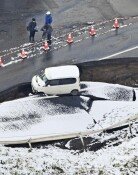‘Black Smoke’ rises as cardinals fail to elect new pope
‘Black Smoke’ rises as cardinals fail to elect new pope
Posted May. 09, 2025 07:19,
Updated May. 09, 2025 07:19

On Thursday (local time), black smoke billowed from the chimney of the Sistine Chapel in the Vatican, signaling that the Catholic College of Cardinals failed to elect a new pope in the first vote of the secret conclave. Starting Friday, the second day of the conclave, four votes are scheduled each day, raising the possibility that a new pope could be chosen as early as that day. As the process unfolds, attention is growing inside and outside the Vatican over whether the new pope will continue the bold reform agenda of the late Pope Francis.
When black smoke rose from the Sistine Chapel chimney around 9 p.m., sighs rippled through the crowd of approximately 45,000 gathered in St. Peter’s Square. According to Reuters and other sources, it took more than three hours from the start of the conclave for the smoke to appear — about an hour longer than during the first vote of the 2013 conclave that elected Francis.
After the vote, the cardinals returned to the Domus Sanctae Marthae, the Vatican guesthouse, to end the day. Only one vote is held on the first day of the conclave. This initial ballot is considered a preliminary round in which electors gauge the field of candidates, making it unlikely that a pope will be chosen at this stage.
Typically, serious contenders begin to emerge on the second day. Starting Friday, four votes will be conducted daily. The first vote is expected around 10:30 a.m. If no candidate receives the required two-thirds majority (at least 89 votes), a second vote will be held at noon, followed by lunch. Additional rounds are planned for about 5:30 p.m. and 7 p.m. If no pope is elected, black smoke will rise after the second and fourth votes; if one is chosen, white smoke will appear immediately.
Based on recent conclaves, the Catholic Church expects a new pope to be elected as early as Friday or no later than Sunday. The last two conclaves both concluded on the second day: Pope Francis was elected in 2013 after five ballots, and Pope Benedict XVI in 2005 after four. According to NBC News, conclaves have lasted an average of three days since 1900. If there is no significant disagreement among the cardinals, a new pope is likely to be chosen by the second or third day.
However, some observers believe this conclave may take longer, as it includes the largest and most internationally diverse group of electors in history. “It looks like it will take longer than the last conclave,” Cardinal Timothy Dolan told The New York Times.
Ji-Sun Choi aurinko@donga.com
Headline News
- South Korea’s migrant population surpasses five percent
- U.S. acting ambassador affirms joint exercises with South Korea
- China and Japan escalate dispute over naval radar incident
- Uptempo claims D3 Seoul basketball championship convincingly
- Democratic Party pushes insurrection court despite opposition warnings







